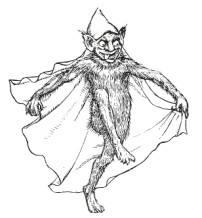A good GM is one part entertainer and one part engineer. And, like a magician, you are only as good as your last trick. Players are like a savvy audience at a magic show—you aren’t going to wow them with the standard magic act. All too often, it seems like they’ve seen behind the curtain. So, when you apply templates to a monster, doing so can be akin to using a little of the magician’s skill at misdirection: The player expects to see the same old monster, but when he or she gets something unexpected, suddenly it’s magic!
 In terms of templates, the advanced template can be applied quickly, and it adds challenge to the encounter, but it can fall short of instilling a sense of wonder, awe, or fear that a monster can bring to the combat. The young template applied to a monster outside the player characters’ CR can make for an exciting encounter, but it takes a deft hand to work with it in a way that doesn’t guarantee a total party kill. Also, you can apply the giant-sized template to make your monster bigger and badder in a way that’s more exciting than the advanced template, but then you’re faced with making it work for the story and campaign flavor that resides in each monster’s entry.
In terms of templates, the advanced template can be applied quickly, and it adds challenge to the encounter, but it can fall short of instilling a sense of wonder, awe, or fear that a monster can bring to the combat. The young template applied to a monster outside the player characters’ CR can make for an exciting encounter, but it takes a deft hand to work with it in a way that doesn’t guarantee a total party kill. Also, you can apply the giant-sized template to make your monster bigger and badder in a way that’s more exciting than the advanced template, but then you’re faced with making it work for the story and campaign flavor that resides in each monster’s entry.
A great contrast to the civilized template is to make your next monster more monstrous. Join me after the jump for a handy way to customize monsters with a balanced approach. I introduce mutated monsters, the next rabbit to pull out of your old magician’s hat.
Fantasy settings tend to be dynamic environments. Magic and alternative physics can explain the changes to your monsters and lead to exciting new plots. Natural selection and the slow-moving hand of evolution provide another option. Players have a tendency to seek an explanation when your monsters aren’t what they expect, and this can lead into some delightful rabbit holes for the creative GM.
The Advanced Player’s Guide gave GMs a fantastic way to add customization to existing monsters: The summoner’s eidolons evolve as they level with a variety of options, and we’re going to use those options to breathe new life into some of our old favorite monsters. To follow along, you can reference that system here. Customizations range from a 1–4 point value.
As a rule of thumb, the higher the CR of your monster, the fewer evolutions it takes to raise them by a CR. I’d use 5 points for anything CR 1–4. Those CR 5 critters need fewer points to go to CR 6—I found 3 to be enough. Also, treat your monster’s Hit Dice as being its eidolon level for evolutions that have prerequisites. Another useful way to balance points (especially if you don’t wish to alter a monster’s CR) is to take a step plus from Con, Str, or Dex for 2 points, Int, Wis, or Cha for 1 point; if you are willing to give up a monster’s feat, I translate that to 3 evolution points.
To see this in action, watch for part 2, where we will explore the system detailed above by providing some examples. Thematically, goblins, worgs, and trolls seem well suited to this exercise, so we will raise their CRs by 1.

